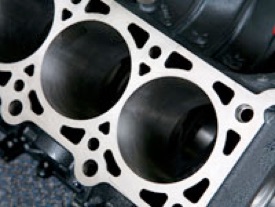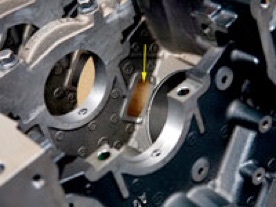Using The New Boss 5.0L
For about a decade now we’ve been supplying very well done “forged” 4.6L Ford engines that are used in various passenger car, light truck, and above all our most popular customers…. the Mustangs. We offer our forged 4.6L for the 2-valve, 3-valve, and 4-valve combinations.
Before I get into the new BigBore FRP block known as the BOSS-5.0, and why we like it; I want to go into some of our configurations, and thoughts on our basic and stroked forged short blocks.
Besides the usual forged rebuilds that we do consisting of; steel cranks, or even stock “cast” crankshafts some times, combined with good steel rods, and above all; a forded piston. Starting a few years ago we also began stroking the popular 4.6’s too. This would bring a typical 4.6L (281cu in) to about 5.0L, or 300cu in. with a .020 overbore on the cylinders. Stock, production “iron” 4.6L blocks can safely handle .060 overbore bringing those to 307 cubic inches when stroked. We’ve had terrific success with our modular stroker combinations in every 4.6L application we can think of.
One of the key reasons we try to push most of our “forged” short block customers into stroking while their in there any way is; a lot of people need to under stand that some times when adding a steel crank in general (if not equipped with stock) along with a good heavy-duty steel connecting rod, and to top it all off — a beefy forged piston too…. All of this starts to make the rotating assembly weight a lot more then the standard rotating components. Quite often when going to a forged short, if other steps, modifications or upgrades aren’t taken into consideration, you could potentially and realistically loose some power simply from getting into the heaver/beefier rotating assembly. This is one of the key reasons that we at Alternative Auto try now days to get our customers to seriously consider stroking they’re new short blocks when working with us on 4.6L replacement engine.
Because of the potential power loss from the heavier forged rotating assembly, there are a couple of other things we try to do also in an effort to make sure that the new forged short will right off the bat make equal to, or better then stock power. First off on almost all of our forged short blocks regardless of stroking or not, we shoot for no less then 10.25 to 1 compression. No matter what the combination is gonna end up with. This is a good all around compression ratio we found because it greatly enhances the performance of most of the 2-valves that are usually at 9.0 to 1, and most 4-valve and 3-valve applications that start out at about 9.8, and a couple of years worth of 4-valve motors were at 10.1 to 1 from 2003 to 2004 in several Ford products.
We’ve found with proper tuning, and 93 octane (or race fuel in more aggressive/higher boosted set-ups) that 10.25 to 1 compression is a good all around number even if the application is headed for some mild boost in its future, or is already seeing boost of some sort. Not every thing is done at 10.25 to 1 though, but most are on our watch with great results and tuning durability.
Secondly along with a compression bump on our forged short blocks… as mentioned previously we try to per-sway our engine job customers into stroking too. By stroking along with a compression bump, and lets not forget some other enhancements like head work and a cam swap etc. You start to see where this is going. The key thing is we don’t want to see our forged short blocks induce a potential power loss just from forging the bottom end due to the heavier rotating components. So by considering stroking it along with our recommended compression bump, this helps insure that your new forged modular short block will not cause a potential power loss right off the bat just because you choose to go for a stronger, heavy-duty rotating assembly.
This finally brings me to the new FRP — “BOSS-5.0” — BigBore iron 4.6L replacement block. Starting a few years ago, adding BigBore sleeves to stock aluminum 4.6L blocks was a little bit popular, but proved to be very expensive, and for us caused some durability problems and even head gasket retention problems. I’m a very big proponent of the stock aluminum 4.6L blocks in very high horsepower applications; even stroking them (against what other might believe) has been very good to us.
But for the guy looking to get into a little something more, along with stroking when getting into a new forged short. Or have considered a 5.4L engine conversion. Then this new FRP modular block and its potential, is something worthy of some attention.
This new FRP block is looking real good to us, and we’ve already seen some of its potential. The new BOSS-5.0 iron block starts out at 3.700 bore (stock = 3.55), and when combined with a 3.750 stroker crank (stock = 3.55), you end up with 323 cu in or a 5.3L. Aside from the approximate 90lbs weight penalty… this new block in my opining is something very interesting to consider if the budget allows when looking into a replacement motor in a 4.6L application. This combination gives you a 42 cubic inch bump from the stock 281. Combined with just mild head work and a cam change of some kind, we’ve already seen some impressive results with these “BigBore-Strokers” in a couple of blower applications.
This in my opining is also a more practical thing to consider if you’re having thoughts about trying to install a dimensionally larger 5.4L where a 4.6L originally was. Especially in Mustangs that were of the 2004 models years and older. Their just isn’t enough conversion parts (header, intakes, hood clearance, front dress, etc) out there to make a 5.4L swap worth the trouble in my opining. And with the BigBore Stroker combo, your only 8 cubic inches shy of a 5.4L, with far more compatibility with the new BOSS-5.0 block which retains all of the standard 4.6L block mounting, and long block geometry.
Just to give an idea of the power potential of the new 5.3L BigBore-Stroker we’re starting to offer. We’ve got a customer’s 2004 Marauder equipped with one of these new motors with no major head porting on the stock 32V heads, and some mild Crower cams. Topped off with an intercooled Trilogy 2.3L twin screw blower, making only 13psi of boost from about 4800rpm and up. Burning only 93 octane fuel, and going through the Marauder’s automatic trans and powertrain… this car produces a touch under 580hp at the rear wheels, with what I feel is a moderately conservative tune with both the A/F and spark. This car has a seriously long and wide torque band. Not to shabby for only 13psi and 93 octane going through an auto trans! The old saying “No Replacement For Displacement” still holds true with me. Especially in street cars that are looking for more grunt from street light to street light.





